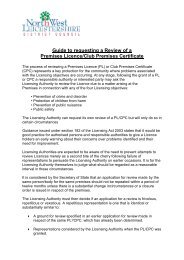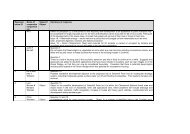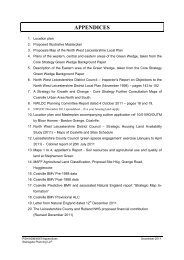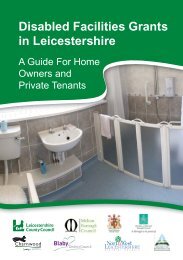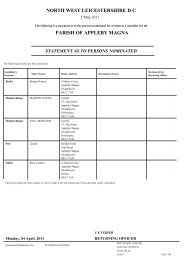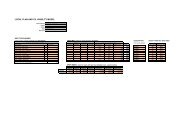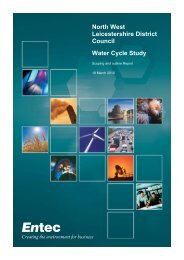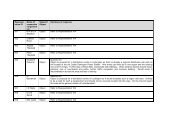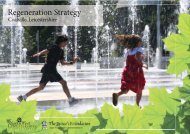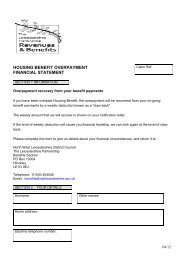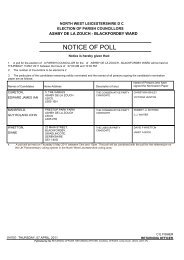Malcolm Reeve Rebuttal Proof of Evidence - North West ...
Malcolm Reeve Rebuttal Proof of Evidence - North West ...
Malcolm Reeve Rebuttal Proof of Evidence - North West ...
You also want an ePaper? Increase the reach of your titles
YUMPU automatically turns print PDFs into web optimized ePapers that Google loves.
TOWN AND COUNTRY PLANNING ACT 1990<br />
APPEAL BY: William Davis Ltd and Jelson Ltd<br />
Land <strong>North</strong> <strong>of</strong> A511 Stephenson Way, Coalville,<br />
Leicestershire<br />
<strong>Rebuttal</strong> <strong>Pro<strong>of</strong></strong><br />
<strong>of</strong>:<br />
M J <strong>Reeve</strong><br />
BSc, FISoilSci, CSci, MBIAC, MCIWEM<br />
on NWLDC’s evidence on agricultural land quality.<br />
Land Research Associates Ltd<br />
Lockington Hall<br />
Lockington<br />
Derby DE74 2RH<br />
Tel: 01509 670570<br />
Fax: 01509 670676<br />
E-mail: malcolm@lra.co.uk<br />
Appeal reference: APP/G2435/A/11/2158154<br />
Date <strong>of</strong> Hearing: 7 th February, 2012<br />
Date <strong>of</strong> pro<strong>of</strong>: 20 th January, 2012
1 QUALIFICATIONS AND EXPERIENCE<br />
1.1 My name is <strong>Malcolm</strong> James <strong>Reeve</strong>. I am a Bachelor <strong>of</strong> Science (Geography & Geology) <strong>of</strong><br />
the University <strong>of</strong> Bristol, a Fellow and past President <strong>of</strong> the Institute <strong>of</strong> Pr<strong>of</strong>essional Soil<br />
Scientists and a Member <strong>of</strong> the British Institute <strong>of</strong> Agricultural Consultants. My<br />
qualifications, experience and instructions in the matter <strong>of</strong> agricultural land quality are<br />
provided in my pro<strong>of</strong> <strong>of</strong> evidence, so are not repeated here.<br />
2 NORTH WEST LEICESTERSHIRE DISTRICT COUNCIL (NWLDC) EVIDENCE<br />
2.1 Agricultural land classification evidence on behalf <strong>of</strong> the council is provided in section 8 and<br />
associated appendices 14-19 <strong>of</strong> the pro<strong>of</strong> <strong>of</strong> evidence <strong>of</strong> Andrew Murphy. My comments on<br />
the evidence are provided below, referenced to each paragraph <strong>of</strong> Mr Murphy’s pro<strong>of</strong>.<br />
Paragraphs 8.1-8.4<br />
2.2 These paragraphs are factual accounts <strong>of</strong> national and regional planning guidance and are<br />
not contested.<br />
Paragraph 8.5-8.6<br />
2.3 The figures quoted are from our original baseline survey <strong>of</strong> an area 8 ha larger than the final<br />
application area. More accurate figures are given in my pro<strong>of</strong> <strong>of</strong> evidence but the<br />
differences between the two sets <strong>of</strong> figures are not significant. However, as explained in my<br />
main pro<strong>of</strong>, it is the distribution <strong>of</strong> the subgrade 3a land that is significant for agricultural<br />
use. Except for the two fields alongside Hall Lane that are entirely <strong>of</strong> subgrade 3a land, the<br />
remainder is distributed as parts <strong>of</strong> fields where land use is controlled by the poorer subgrade<br />
3b land. This constraint has been confirmed by the long-term farmer <strong>of</strong> the land.<br />
2.4 Mr Murphy states that there is no indication that the illustrative masterplan takes account<br />
<strong>of</strong> the location <strong>of</strong> the best and most versatile land. However the only two fields that are<br />
dominated by subgrade 3a land will remain in a ‘green’ use as playing fields and, in<br />
consequence, will remain as a potential agricultural resource if required in the future.<br />
Subgrade 3a land in the western end <strong>of</strong> the application area will be converted to open space<br />
and woodland planting, similarly retaining agricultural potential.<br />
Paragraphs 8.7-8.8<br />
2.5 Mr Murphy is wrong to the link the quality <strong>of</strong> the agricultural land within the appeal site<br />
with the fact that it is designated as Green Wedge. PPS7 states, at Paragraph 28, that “the<br />
presence <strong>of</strong> best and most versatile agricultural land …. should be taken into account<br />
alongside other sustainability considerations”. In the case <strong>of</strong> the appeal proposals, this<br />
means that it is appropriate for the decision maker to have regard to the sustainability<br />
credentials <strong>of</strong> the proposed development when weighing in the planning balance the extent<br />
<strong>of</strong> harm likely to be caused to land <strong>of</strong> the best and most versatile agricultural quality. And,<br />
the sustainability credentials <strong>of</strong> the appeal proposals are undeniably excellent. Developing
in conflict with Policy E20 <strong>of</strong> the Local Plan does not render the appeal proposals<br />
unsustainable, in fact quite the opposite is true. Accordingly, it is inappropriate to suggest<br />
that a conflict with Policy E20 should increase the weight that one affords to the protection<br />
<strong>of</strong> the best and most versatile land. This is clearly not the case and not what is intended by<br />
PPS7.<br />
Paragraphs 8.9-8.10<br />
2.6 These deal with available information on the agricultural quality <strong>of</strong> land around Coalville<br />
using much <strong>of</strong> the same information that I have presented in my main pro<strong>of</strong> <strong>of</strong> evidence.<br />
The followings points need making:<br />
• Appendix 18 reproduces an extract from the provisional agricultural land classification<br />
(ALC) mapped produced in the 1970s when the classification was different.<br />
• The map in Appendix 15 reflects a next stage in development <strong>of</strong> the ALC system when<br />
MAFF surveyors were tasked in the 1980s with dividing grade 3 land into three<br />
subgrades, applying a protocol that ignored any grade 3 land being reclassified as grade<br />
2 (or vice versa). This classification was superseded in 1988 when the current<br />
classification was introduced. Consequently, both <strong>of</strong> these maps must be interpreted<br />
with care, as pointed out by the letter from English Nature that is reproduced as<br />
Appendix 19 <strong>of</strong> My Murphy’s pro<strong>of</strong>.<br />
• The results <strong>of</strong> the post-1988 survey around Bardon Grange in Appendix 16 is referred<br />
to in Table 2 <strong>of</strong> my pro<strong>of</strong> where I state (In relation to SHLAA site C23) that most land is<br />
<strong>of</strong> subgrade 3b agricultural quality.<br />
• Natural England’s map <strong>of</strong> ‘Predictive Best and Most Versatile Land’ reproduced as<br />
Appendix 17 is based on published soil mapping, some <strong>of</strong> it carried out by myself during<br />
the 1980s. It is no coincidence that my predictions, carried out independently and<br />
reproduced as Map MJR 3 <strong>of</strong> my pro<strong>of</strong>, give similar results.<br />
2.7 Mr Murphy uses the caveats attached to the English Nature maps to contend that it is not<br />
possible to reach reliable conclusions whether any <strong>of</strong> the 36 SHLAA sites are based on best<br />
and most versatile agricultural land. While I appreciated that a desk-based assessment is no<br />
substitute for a detailed survey <strong>of</strong> agricultural land quality, all indications from soil maps<br />
and English Nature’s predictive exercise are that SHLAA sites C18, C24-27, C30 and C40 are<br />
on best and most versatile land. In my pro<strong>of</strong> I have been able to go a stage further and<br />
estimate if the sites are predominantly grade 2 or a mixture <strong>of</strong> grade 2 and subgrade 3a.<br />
Paragraphs 8.11-8.12<br />
2.8 The classification <strong>of</strong> agricultural land on the east side <strong>of</strong> Coalville is not in dispute, nor the<br />
presence <strong>of</strong> previously developed sites that might or might not be available for
development. The issue before the inspector is whether the small area <strong>of</strong> usable best and<br />
most versatile land within the Stephenson Green site is a valid reason for refusal.<br />
2.9 In relation to the 27.6 ha site C30, accepted in the SHLAA to be a mixture <strong>of</strong> Grades 2 and 3,<br />
assessed by me to be <strong>of</strong> grade 2 and sub-grade 3a, and predicted by English Nature to be<br />
within an area with more than 60% best and most versatile land, the SHLAA states:<br />
‘The agricultural land classification is not a reason to reject housing on the site’.<br />
2.10 In light <strong>of</strong> the above, Mr Murphy’s arguments in relation to the small area <strong>of</strong> usable<br />
subgrade 3a land on the Stephenson Green site, all <strong>of</strong> it to be retained with agricultural<br />
potential, cannot be accepted.




